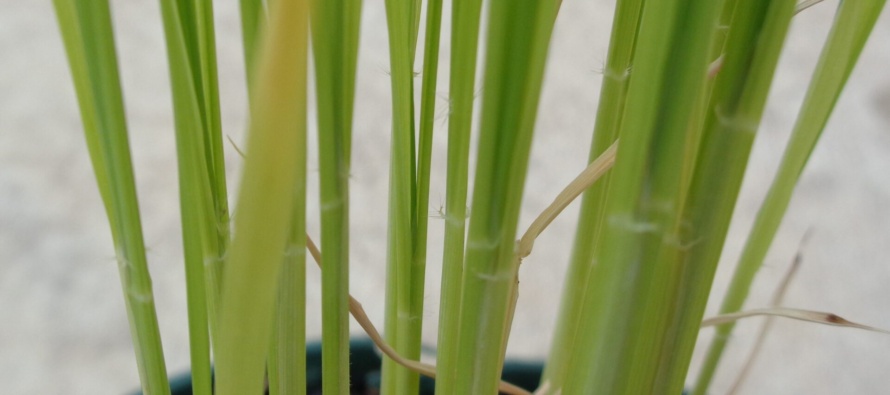Red rice

Related Articles
- Calcium and Magnesium For Mississippi Crops 1
- March 11 Precision Agriculture Workshop 0
- Ground Speed Affects Spray Droplet Deposition 0
Latest Tweets
Red rice
Weed Flora of Mississippi
Prepared by
Taghi Bararpour and Jason Bond
Family: Poaceae
Genus: Oryza Species: sativa
History: Rice (Oryza sativa L.) is an Asian species. China is thought to be its center of origin (Vaughan et al., 2005). Weedy and cultivated rice both evolved from wild Oryza species. In most regions of rice production, red rice is introduced after the transition from transplanting rice to sowing commercial seeds directly in the rice field. Herbicide-resistant rice was developed primarily to selectively control red rice in rice (Gealy and Dilday 1997). ‘LibertyLink’ rice was the first transgenic rice developed. However, because of concerns in the international market about genetically-modified rice, it was not commercialized. ‘Clearfield’ (CL) rice, which was intentionally mutated to tolerate imidazolinone herbicides without the introduction of any foreign gene, was commercialized in 2002. However, the introduction of herbicide-resistant rice has raised concerns about its potential hybridization with red rice and the impacts of increased weediness of crosses on the rice production systems and the future of herbicide-resistant rice technology. In the U.S., red rice infestations were reported as early as 1846 (Allston, 1846), but it is generally believed that red rice was introduced to the U.S. at a much earlier date.
Taxonomically, red rice is identical to commercial rice (Kwon et al. 1991). Although first reported in North and South Carolina in 1846, red rice soon infested fields in Arkansas, Louisiana, and Texas by the early 20th century. In Arkansas, red rice has been considered as the worst weed problem in commercial rice for more than 90 yr. Today, red rice is one of the top 10 most troublesome weeds of cultivated rice in the southern U.S. (Dowler 1994; Noldin et al. 1999). In the early 1970s, the federal government relaxed controls on the area planted to rice and the area planted in Mississippi more than doubled within two years. Within a couple of years farmers began to complain about red rice in their fields. Alarmed by the introduction and rapid spread of red rice in the state, the rice producers requested that the seed technology laboratory of Mississippi State University undertake studies to obtain information on the extent and nature of the red rice problem for use in certified seed production and weed control research and development. The first study of red rice in Mississippi was undertaken by Larinde (1979).
Life Cycle: Summer annual aquatic grass
Special Characteristics: A defining feature of red rice is the dark-red-pigmented pericarp (bran) that gives the weed its common name.
Roots: Main roots including one seminal root and nodal roots, and two types of lateral roots (Kono et al., 1972; Yamauchi et al., 1996).
Stems: Upright-growing, 2.5 to 3 feet tall, with bright green stems
Leaves: Green and leaf blades are 1 to 2 feet long and 0.5 to 1 inch wide
Flower: Green, inflorescences is loose, drooping panicle
Seeds / Fruit: It has staggered seed maturity, prone to “shattering” (dropping seed from inflorescence before harvest).
Seedling: It can be distinguished from cultivated rice by presence of long hairs at collar, tall triangular membranous ligule and auricles.
Interference: It is the most dominant, troublesome and economically damaging type of weedy rice. Diarra et al. (1985a) found that populations as low as 5 plants/m2 reduced rice grain yield by 22%. Kwon et al. (1991) reported that grain yield of ‘Lemont’ and ‘Newbonnet’ was reduced by 86 and 52%, respectively, by red rice interference of 120 days. In the southern U.S., red rice infestations can reduce crop harvests up to 80% (Estorninos et al. 2005) and are estimated to create crop losses exceeding $45 million annually (Gealy et al. 2002). Control of red rice has proved difficult because of the weed’s morphological and agroecological similarity to cultivated rice. Moreover, the potential for gene flow from domesticated rice into red rice populations threatens the long-term effectiveness of weed control strategies based on herbicide-resistant crop varieties (Rajguru et al. 2005; Shivrain et al. 2007).






Let me tell You a sad story ! There are no comments yet, but You can be first one to comment this article.
Write a comment